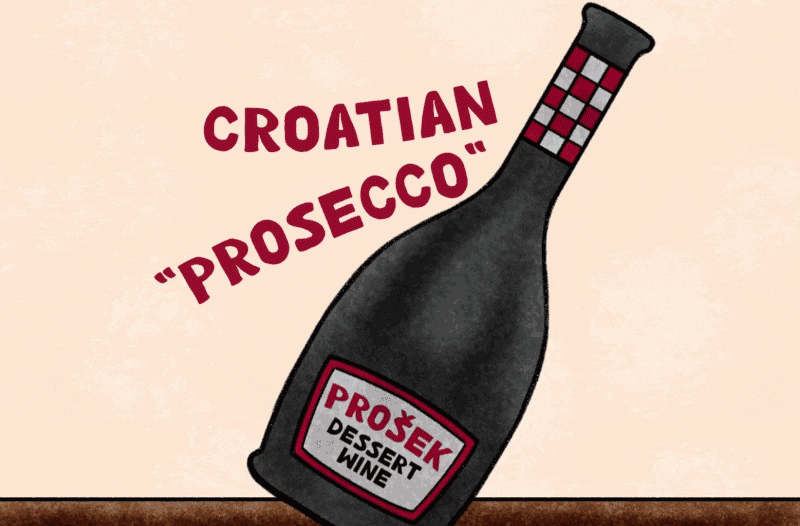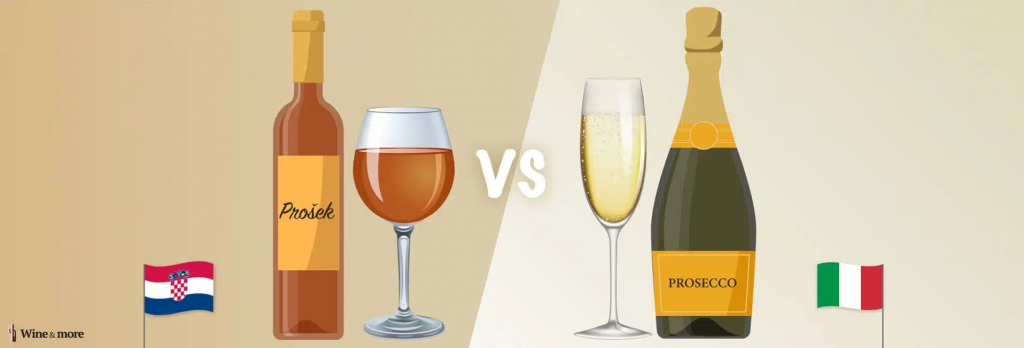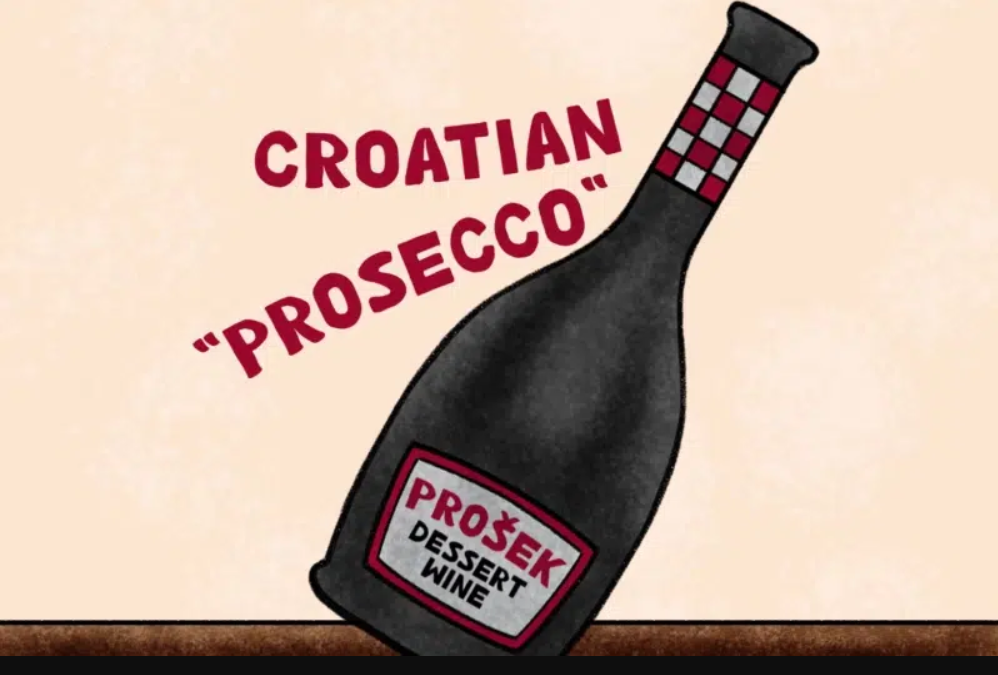December 15, 2023. – Wine, a universal elixir, transcends boundaries, yet the tale of Croatian Prošek and Italy’s Prosecco reveals a divergence that nearly sparked a diplomatic imbroglio, as writes Wine&more. Though their names echo a semblance, these wines stand worlds apart, each boasting a unique legacy and allure.

The controversy around CROATIAN Prošek and ITALIAN Prosecco
In the spring of 2013, on the eve of Croatia’s entry into the European Union, a tempest stirred the wine world. A decree emerged that post-membership Croatian vintners would be prohibited from producing, promoting, or selling Prošek, a cherished traditional sweet wine.
The source of this ban? Allegedly, the consortium of Italian Prosecco makers safeguards their product under EU trademark laws.
The bone of contention was the perceived similarity in names, with claims that Prošek might lead consumers astray. As Prosecco already enjoyed EU protection, the proposal was to rename Prošek.
The Croatian public, especially winemakers, recoiled in astonishment, for anyone acquainted with the wines would attest that their similarities end at the nomenclature.
Unveiling the Distinctions BETWEEN PROŠEK AND PROSECcO

Contrary to the shared nomenclature, Croatian Prošek and Italian Prosecco traverse diverse vinicultural realms, and a closer inspection illuminates their disparities:
Prosecco:
- A sparkling, easy-drinking wine.
- Crafted from grapes with low sugar content and high acidity.
- The Prosecco sparkling wine is produced in the Charmat or Italian Charmat method, developed by Martinotti (the second fermentation takes place in stainless steel tanks);
- Light and bubbly, with up to 12% alcohol content, it offers subtle citrusy and fresh apple aromas.
- Primarily sourced from the Glera grape.
Prošek:
- A sweet dessert wine, rich in alcohol, boasting sweet and nutty aromas.
- Exhibits deep gold, amber, or dark red hues.
- A thick, syrupy still wine made from dried grapes.
- Production involves drying grapes on straw mats or the vine, followed by maceration and extended fermentation and aging in oak barrels.
- Minimum of 1 kilogram of dried grapes needed for 0.75 liters of Prošek.
- Crafted from red or white grape varieties indigenous to the Dalmatian wine region.
Exploring Prošek WINE
Prošek, a sweet dessert wine with roots entwined in Croatian heritage, is meticulously crafted using traditional methods.
Grapes are dried on straw mats or left to naturally dry on the vine, followed by aging in oak barrels before bottling.
Prošek tasting notes
The resulting elixir, with its rich golden hue, offers a complex interplay of sweet and acidic flavors, featuring notes of creamy caramel, dark chocolate, dried fruits, citrus, and Dalmatian spices.
Prošek tasting notes
Depending on variety and production method, Prošek has a rich, golden colour and a complex flavour that is both sweet and acidic.
It is often described as having creamy caramel, dark chocolate, jammy notes of dried fruits, citruses, Dalmatian spices, and sweet barrique notes with almond and walnut aftertaste. The taste is complex, with delicate tannins and integrated freshness.
Prošek wine food pairing
Pairing impeccably with desserts, dry fruits, nuts, and cheese, Prošek is a post-dinner indulgence, a testament to its integral role in Croatian celebrations.
That is perhaps the only similarity between Prošek and Prosecco – both can be enjoyed independently, without any dish to accompany it.
Croatian made “Prosecco-style” wines
While Prosecco is available in Croatian bars, restaurants, cafes, and retail stores, local winemakers venture into production of “Prosecco-style” wines.
Today Blanc
“Today Blanc”, in its essence, is a 100% Graševina grape, meticulously crafted. Grapes are harvested at the peak moment, ensuring a delicate balance of heightened acidity and lower sugar levels. The winemaking process is a symphony of precision – after a gentle press, fermentation unfolds over a maximum of 14 days at a cool 16°C.
The magic continues as the wine gracefully rests, preserved in fine yeast sediment, with a delicate stirring ritual once to twice a week.
Enter the Autoclave tanks, where the secondary fermentation occurs, lasting another blissful 14 days at the same 16°C. Autolysis, a dance of yeast extinction, captivates for a month and a half, bringing depth and character to the wine as fermentation concludes.
This impeccable creation is a welcoming embrace of the vibrant notes of citrus fruitiness and invigorating freshness, subtly kissed with a touch of floral elegance to enchant your palate.
Today Rose

Another Croatian-made example of this general style is a surprisingly balanced Blaufränkisch-based sparkling wine named “Today Rose”.
This Sparkling Rosé, artfully crafted from the expressive Frankovka (Blaufrankisch) grape, begins with a primary fermentation of the base wine at a cool 16°C.
Enter the Autoclave tanks, where the secondary fermentation unfolds, a twelve-day symphony that adds depth and effervescence to the blend. The wine then gracefully ages on yeast for two months, evolving into a masterpiece of balanced taste.
Enosophia Sparkling Frankovka Rose is a harmonious dance of bubbles, a rosé that strikes the perfect balance. It is a surprisingly persistent presence on the palate, with wine’s clarity and elegance as pillars supporting a core of invigorating freshness, inviting you to indulge in a pink sparkling experience.
Nice To See You
Introducing “Nice To See You,” a delightful fusion of Chardonnay and Pinot Noir that promises an exceptional sensory journey. The magic begins with a swift press, followed by sedimentation, paving the way for a meticulous process that elevates this blend to bubbly bliss.
The grape varieties undergo a separate fermentation lasting 12 hours at a cool 16°C, setting the stage for the wine to gracefully rest at fine yeast sediment for three months with a gentle stirring imparts complexity.
Enter the Autoclave tanks, where the secondary fermentation takes flight over a 14-day period, followed by an enchanting autolysis of yeast for a lavish five months. The final touch involves meticulous filtration, preparing this effervescent elixir for its grand debut in the bottle.
Behold the result—a wine that flutters on the palate with an unobtrusive, fresh aroma, showcasing mild fruitiness with distinctive fruity notes and a hint of yeasty complexity. To fully appreciate its charm, serve “Nice To See You” ideally at 6-8°C (43-46℉) in a glass for white wines.
Conclusion
In the world of wines, Prošek and Prosecco may share a name, but their essence diverges in taste, production, cultural significance, and availability. Prošek, a custodian of Croatian heritage, embraces traditional methods, while Prosecco gains global recognition through modern efficiency.
So, whether savoring Prošek’s rich sweetness or Prosecco’s crisp freshness, one can appreciate the distinctive character each brings. Amid the diplomatic saga, these wines stand as flag bearers of cultural identity, inviting enthusiasts to explore and relish the unique story within each bottle. Cheers! 🍷
NOTE: The article was originally written at wineandmore.com











